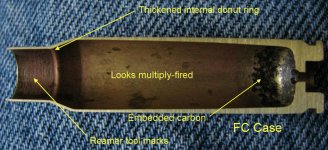biologicole
New member
I have a question about shoulder bump. I believe I may have bumped the shoulder back too far on my .260 Rem reloads. A little background...I received a batch of brass with too large of primer holes and had primers dropping out of the reloaded cartridges as well as falling out of fired cartridge. I acquired a primer pocket gauge and sorted them all out, I think. Here's the problem, after sorting out the large primer pockets, I reloaded the remaining brass. However, I recently shot a deer and had the spent primer fall out of the case. The headspace on the gun has been checked and is correct. I'm absolutely sure the powder charge is isn't excessive and causing pressure problems. I'm wondering if I bumped back the shoulder too far creating excessive headspace and if that's even possible? Would that cause the primer to fall out? Can I use a headspace gauge to check that on loaded ammo? Thanks

